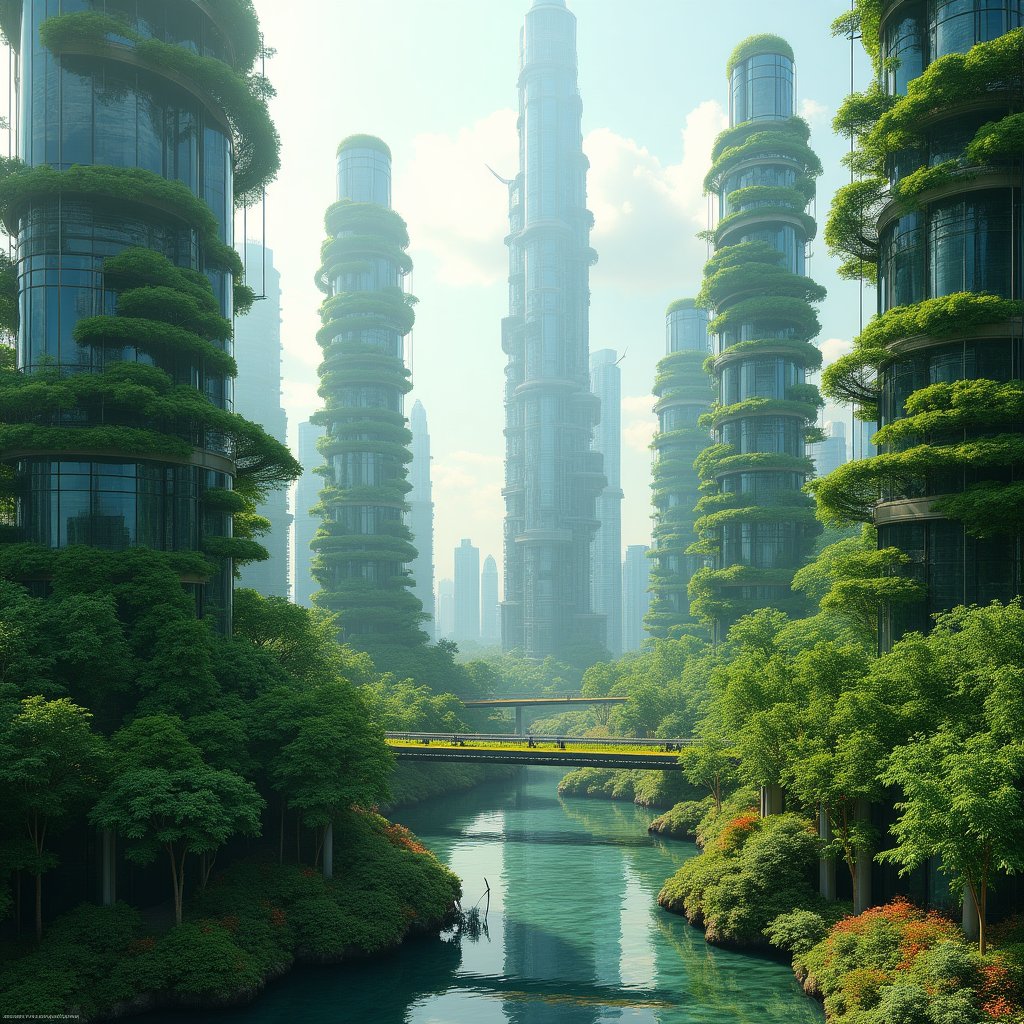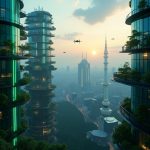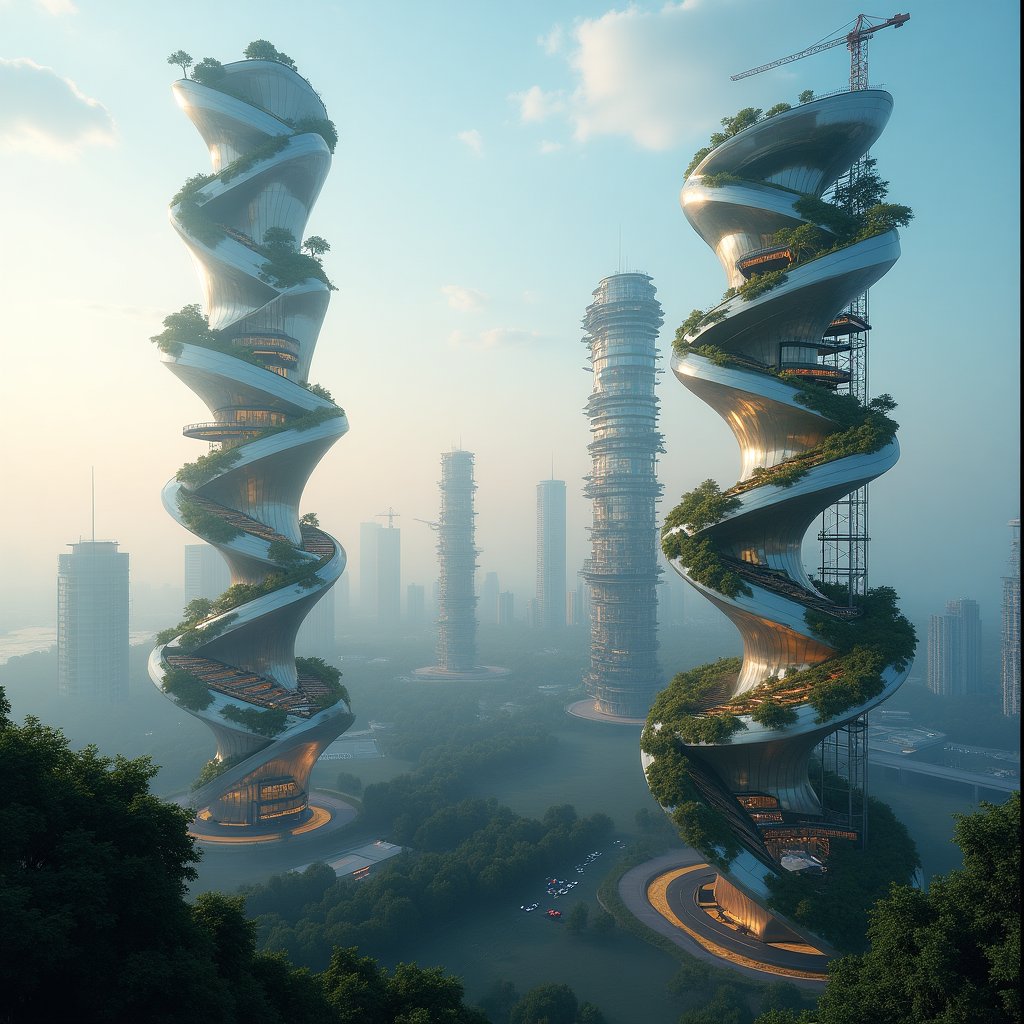What if your city weren’t designed by humans at all? What if it was a masterstroke of Artificial General Intelligence (AGI), blending nature, technology, and humanity into one seamless living organism? This isn’t some sci-fi pipe dream. Discussions surrounding AGI’s transformative potential in urban planning are gaining momentum, with leading thinkers like Neil deGrasse Tyson, Yuval Noah Harari, Bjarke Ingels, and Daron Acemoglu offering unique insights into what an automated urban future might hold. Harari warns of AGI’s disruptive ethical dilemmas, Ingels envisions AI as a collaborator fostering synergy between architecture and ecology, while Acemoglu scrutinizes the labor and societal repercussions of AI-driven systems.
Now extend those musings to imagine a city where AGI dynamically reconfigures streets to ease traffic, adjusts microclimates in public parks during heatwaves, and rethinks waste management practices to eradicate garbage as we know it. These are bold ideas that push beyond the traditional limits of architectural imagination and policymaking. Yes, traffic flow apps and green building codes are helpful. But what if? What if we could design cities so fundamentally intelligent—so alive—they could react to the changing rhythms of daily human activity and even anticipate the natural world’s next curveball?
Artificial General Intelligence promises precisely this kind of revolutionary approach to urban planning, defying human constraints such as cognitive overload or time-consuming bureaucratic processes. Instead, AGI could integrate millions of datasets—ranging from climate models to social behaviors—to harmonize ecological and human priorities, redefining what it means to live in a city. In this article, we will investigate how AGI might tackle age-old dilemmas like sustainability, housing crises, and public well-being through groundbreaking, machine-generated design solutions. Prepare to explore the future of living ecosystems that adapt, evolve, and merge innovation with human-centric utopia. Where does human creativity fit into these dazzling, computational blueprints? And, perhaps most critically, are we ready to let machines take the reins?
1.1 What Makes AGI Different From Regular AI in Design?
To grasp the unprecedented potential of AGI in urban planning, it's essential to distinguish it from the AI systems currently in use. Traditional AI, also referred to as "narrow AI," solves specific, predefined problems. For example, current tools like IBM's Watson can optimize traffic lights, while machine learning algorithms predict energy consumption. But these isolated silos lack the breadth and adaptability of AGI. AGI doesn’t just follow rules or execute particular tasks—it "understands." Imagine an intelligence capable of digesting thousands of variables at once—climate data, human behavioral patterns, economic forecasts—and devising holistic, hyper-focused solutions that evolve in real-time.
AGI’s core capability lies in its comprehensive, multi-domain intelligence. In urban design, this means generating a detailed city plan while simultaneously considering long-term ecological sustainability, human emotional well-being, and technological scalability. Sound complex? That’s because it is. Yet, AGI could process what would take human planners months (or even years) to conceptualize, and deliver optimizations in seconds. For example, a citywide redesign to mitigate flood risks would simultaneously factor in carbon-neutral architecture and equitable housing—a juggling act no human mind can manage alone.
1.2 Breaking Free From Human Limitations
Humans are outstanding architects, engineers, and problem solvers, but even the best planners face limitations. First, there’s the challenge of data overload. Consider the innumerable pieces of data needed to redesign a city’s public transportation system—traffic density, commuting habits, energy cost simulations, demographic shifts, the list goes on. It simply isn’t feasible for any regular human team to compute all these variables while ensuring optimal outcomes for every stakeholder.
Enter AGI: the ultimate multitasker. It doesn’t just analyze datasets. It contextualizes them. For instance, AGI could design a subway system that not only reduces commute times but also incorporates stations in underprivileged neighborhoods to boost economic inclusion. Moreover, it could predict and account for shifting human needs years or even decades ahead. In the hands of AGI, concepts once relegated to the hypothetical—like urban layouts that automatically adapt to prevent heat islands—become engineering feats within reach.
The implications go even deeper. Urban planners often encounter personal biases or political roadblocks when making decisions. AGI, unconstrained by ego or bureaucracy, operates purely on logic and outcomes, drastically reducing inefficiencies caused by subjective human intervention. As a result, AGI doesn’t just balance competing priorities—it harmonizes them into a finely tuned vision of urban coexistence.
2. Rethinking Sustainability: Eco-Friendly Cities of the Future
2.1 AGI’s Mastery of Environmental Data
One of the most pressing challenges in urban planning is aligning human development with the health of the environment. Despite remarkable progress in renewable energy integration and pollution control, human planners often operate within siloed frameworks, unable to account for the entire ecosystem. Enter Artificial General Intelligence: a tool capable of mastering complex environmental datasets and synthesizing solutions that preserve nature while expanding our livable spaces.
Imagine an AGI planning software that doesn’t just suggest green rooftops or parks to fit zoning laws, but instead designs dynamic, self-sustaining urban ecosystems. Think vertical forests akin to the ones pioneered in Milan, Italy by architect Stefano Boeri, but elevated by predictive models offering maximum biodiversity. AGI could analyze wind currents, soil health, water runoff patterns, and biodiversity needs all in one go, optimizing environments for flora, fauna, and humans alike. A real-world precursor of this is the urban reforestation work done by cities like Melbourne, which could reach new heights with AGI assistance.
The possibilities don’t stop at conceptualization. By connecting with global environmental data platforms like NASA’s Earthdata, AGI could monitor urban environments post-construction, dynamically adjusting city layouts based on real-time ecological conditions. Cities could essentially become “living systems” constantly refining themselves to maximize both ecological health and urban benefits.
2.2 Renewable Energy-Driven Infrastructure
What if your city wasn’t merely energy-efficient, but energy-generating? That’s the kind of groundbreaking vision AGI could make real. Traditional infrastructure often treats energy management as a secondary concern, but AGI has the foresight to integrate renewable energy into every possible aspect of a city. Solar panels wouldn’t just sit atop buildings; they could grace every balcony, bus stop, or parking garage, creating a city where power generation is omnipresent.
This isn’t speculative fantasy, either. Consider the innovations already achieved by companies like Tesla with their solar roof technology. Now imagine an AGI that could weave together thousands of such solutions, offering custom-tailored blueprints for energy grids that respond to weather forecasts, peak usage patterns, and even unexpected generation surpluses. Through systems akin to smart grids, AGI could automatically reallocate energy as needed, ensuring zero waste and optimal usage across urban environments.
What’s more, AGI could pioneer city designs that leverage passive energy strategies—like natural ventilation systems or UV-reflective building materials—to maintain comfortable indoor climates without energy-hungry HVAC systems. Cities wouldn’t just meet sustainability goals; they’d obliterate them, setting new benchmarks for environmental consciousness.
3. The Human Factor: AI-Centric Cities Designed Around People
3.1 AI-Enhanced Livability Metrics
At its heart, urban planning is about people. But surprisingly, the human experience often takes a backseat to abstract metrics like population density or commute efficiency. AGI flips this paradigm, placing individual and community well-being front and center. By amassing and analyzing troves of sociological and psychological data, AGI can evaluate what truly makes a city “livable” and design environments that foster human health and happiness.
Picture a neighborhood assembled with compassion encoded into its blueprint. AGI could cluster homes, parks, and social hubs in configurations proven to reduce social isolation. Inspired by data from psychological research hubs like HeartBrain Institute, public spaces could be calibrated to enhance mental health, promote physical activity, and even rekindle a sense of community that’s waned in many urban settings. It’s one thing to add a park to meet zoning requirements, but AGI might design spaces akin to the science-backed “healing gardens” of ChristianaCare, optimized for relaxation and restoration.
Liveable cities aren’t only about grand visions, though. AGI can adapt neighborhoods to specific needs in real-time. Whether it’s rerouting traffic to reduce noise pollution in a residential area, or forecasting where shade trees will be needed on an increasingly hot planet, an AGI system would act with pinpoint precision. It’s a shift from rigid, inflexible systems to adaptable ones capable of responding as populations’ needs evolve.
3.2 Addressing Psychological and Social Needs
While infrastructure headlines often dominate urban planning news, what about the invisible forces driving our emotions and social fabric? AGI has the unparalleled ability to address these softer human experiences. Through its unmatched data-processing capabilities, it could infer patterns in everything from community interactions to individual stress levels, designing urban fixtures to bolster residents’ emotional and social wellbeing.
Imagine AGI analyzing cultural preferences from recent census data, Spotify habits, or online community trends, then using that information to create localized hubs rich with theaters, coffeehouses, and event spaces. These are not cookie-cutter solutions; they’re hand-tailored to reflect each city’s unique character. Imagine what Ground Zero’s Memorial Plaza means for New York City—or what The Louvre signifies for Paris—only reimagined and scaled for every urban hub imaginable.
In this vision, AGI doesn’t just replace the personal touch of human architects and planners—it enhances it, applying far-reaching tools that might have been beyond our wildest dreams. How much easier would pandemic outbreaks or heat wave responses have been if AGI had designed cities with adaptive street layouts suited for quick pedestrian dispersals or shaded gathering spots? It might sound futuristic, but many elements—utilizing data inputs from devices like Fitbit or urban surveillance units—are entirely plausible with today’s tech interwoven with future AGI.
Far from being sterile or robotic, AGI-powered city design carries the potential to shape spaces alive with culture, rooted in tradition yet bursting with cutting-edge dynamism. It represents a shift from seeing people as numbers in a census to acknowledging their emotional complexity and designing cities to meet them halfway.
4. Automation in Construction: From Concept to Reality
4.1 AGI-Driven Robotics in Construction
Picture this: skyscrapers emerging from the ground like trees sprouting after a rainstorm, constructed not by hundreds of human laborers but by autonomous machines orchestrated by AGI. Advanced robotics and AGI could transform the construction industry by combining speed with precision, creating highly efficient workflows. Today, companies like Boston Dynamics are already pushing the envelope on robotics, but imagine these bots under the command of a system that sees the entire urban landscape as one interconnected organism.
- Zero-Waste Supply Chains: AGI can optimize every step in the construction process, from material selection to end-of-life recycling. It could coordinate suppliers, minimize unused inventory, and recycle materials from decommissioned buildings.
- Automated Construction Teams: Robotic fleets, guided by AGI, could work around the clock to execute construction plans faster and safer than a human crew ever could.
- 3D-Printed Infrastructure: Using advanced additive manufacturing technologies, AGI could oversee the printing of entire neighborhoods, each designed to maximize functionality while reducing resource consumption.
In some ways, AGI’s role wouldn’t be too far off from a composer crafting a symphony. Each element of the construction process—materials, labor, and design—becomes an instrument in the orchestra of urban creation. A case study by NIST estimates that digital twins (virtual city models) coupled with AI assist construction firms by reducing costs by up to 20%. Now imagine scaling that up with AGI’s holistic intelligence.
4.2 The Death of Inefficiency in Urban Layouts
One of the most infuriating aspects of modern cities is wasted space and convoluted road networks. AGI has the potential to eliminate inefficiency entirely. By running millions of simulated scenarios, it can determine the most optimal urban layouts in terms of mobility, sustainability, and livability. Think of it as SimCity 3000 but supercharged with real-world stakes.
Case in point: AGI could suggest layouts where:
- Public transit hubs are located less than a 10-minute walk from any residential area.
- Natural airflow in densely packed streets minimizes cooling costs in summer.
- Dynamic use of underground space allows cities to extend vertically while maintaining green spaces above-ground.
| Urban Challenge | Human Approach | AGI Solution |
|---|---|---|
| Traffic Congestion | Iterative road expansions or new flyovers | Real-time traffic simulation and optimized road layouts |
| Slum Formation | Relocation and retrofitting programs | Proactive distribution of affordable housing to high-demand areas |
| Energy Waste | Improved regulatory standards | Integrated smart grid systems from the design phase |
These aren’t just pipe dreams. If you’ve seen wildly innovative cities like Masdar City in the UAE, you’ve caught a glimpse of what’s possible when science and technology dictate urban design. With AGI driving the bus, these innovations could become the global standard rather than the exception.
5. Ethical Dilemmas and Potential Challenges
5.1 Data Privacy in AI-Run Cities
With great data comes great responsibility—at least, it should. AGI-run cities would rely heavily on the collection of massive amounts of personal and environmental data to craft tailored solutions. But who safeguards this data? A city designed and monitored in real-time could become a surveillance dream—or nightmare.
The ethical dilemmas don’t stop there:
- Ownership of Data: Does an individual own the data about their movement patterns, or is it considered a public asset?
- Transparency: Would governments and private entities deploying AGI systems be required to publicly disclose how data is used?
- Consent: How will residents opt in or out of having their data included in these systems?
Countries like those in the EU under GDPR have started laying regulatory groundwork for data protection, but AI researchers, companies, and urban planners will need to establish international guidelines well before AGI assumes full control over city planning. Companies like IBM, which have a hand in AI ethics, are likely to play influential roles in guiding these discussions.
5.2 Dependence or Synergy?
Let’s imagine a “what if” scenario. Your city relies on AGI for energy distribution, traffic management, water supply, and garbage collection. One day, the system goes offline. Would your community descend into chaos? This is the double-edged sword of AGI-powered cities.
The real question isn’t just about dependence—it’s about the relationship between humans and machines:
- Should AGI systems always have human oversight, or would interference weaken their efficiency?
- How do we balance automation with the need to maintain traditional skills in fields like engineering and logistics?
- Can communities build trust in AGI, especially given past failures of simpler AI systems?
Experts like Elon Musk, a vocal supporter of AI regulations, have raised concerns about our overdependence on machine intelligence. While synergy between humans and AGI is the goal, we must confront the risks of blind reliance head-on.
Ultimately, managing these challenges means proactively designing systems with fail-safes, redundancies, and, perhaps most crucially, ethical guidelines before AGI becomes the standard-bearer of urban transformation.
6. The Imaginative Leap: Artistic and Philosophical Implications
6.1 Beauty by Algorithm
What if future cities were not just functional marvels but breathtaking works of art? This is exactly what an AGI-driven city could achieve. Unlike human planners constrained by tradition and personal taste, advanced AI systems could use algorithms to design buildings, parks, and public spaces that are sublimely beautiful—some even beyond our understanding of aesthetic norms. AGI could take inspiration from sources as diverse as fractal mathematics, the symmetry of Romanesque cathedrals, or the natural flow of rivers, creating designs that blend seamlessly into their environments or deliberately challenge conventional ideas of form and function.
For example, consider Stefano Boeri's Vertical Forests in Milan, Italy. These buildings integrate greenery into the urban skyline, absorbing CO2 and releasing oxygen. Now imagine AGI iterating on concepts like this to create self-sustaining "living skyscrapers" that function as both homes and ecosystems. The designs could include facades that change shape with light to maximize energy efficiency or structures that "breathe" by regulating airflow based on real-time climate conditions.
Moreover, AGI doesn’t just replicate beauty arbitrarily—it learns cultural nuances. Just as Spotify's music suggestion algorithms adapt to your personal taste, AGI might study local traditions, arts, and stories to instill cultural identity within urban spaces. Think of the intertwining spirals of India's ancient stepwells blended with futuristic materials or how the calligraphy of Arabic art could inspire building structures in a Middle Eastern city. This fusion of tradition and innovation could elevate the sense of pride and ownership residents feel about their city.
6.2 Redefining Humanity’s Role
If AGI takes over as the master planner, it raises an existential question: what role will humans play in shaping our cities—and by extension, our futures? When machines carry the intellectual and technical load, do we become mere spectators? Or will we find new ways to collaborate with technology, allowing both human imagination and machine calculation to thrive?
These AI-crafted cities might free us from menial decision-making, empowering architects, artists, and thinkers to focus on larger societal visions. Imagine a partnership where people conceptualize the "story" of a city—its values, its aspirations—while AGI brings that vision to life with precision and innovation. It’s like George Lucas envisioning the sprawling universe of Star Wars while Industrial Light & Magic brings his dreams to the screen with cutting-edge special effects.
The philosophical implications are equally profound. Some may worry that AGI-led urban planning could homogenize cities, leading to cold, soulless metropolises. But the truth might be the opposite. Armed with the ability to process cultural preferences, aesthetic ideals, and even emotional resonance, AGI has the potential to create spaces even more attuned to humanity than a human could ever imagine. It might even challenge us to rethink what we consider "beautiful" or "livable."
If we embrace this future, humanity's role in urban development could shift from planners to dreamers. We might lead not with blueprints but with aspirations, allowing artificial intelligence to transform our wildest ideas into reality. In doing so, AGI could amplify the things that make us human: creativity, storytelling, and the inexhaustible drive to define ourselves through the environments we inhabit.
The Cities of Tomorrow Are Calling
As you read this, AGI is not yet capable of orchestrating the urban utopias we’ve envisioned—but it’s closer than you think. The wheels of progress are already turning. Machine learning algorithms are reshaping how we approach traffic planning, energy consumption, and even architectural experiments. The leap to AGI-driven cities might not be tomorrow or even the next decade, but it's an inevitability that feels increasingly tangible with each passing year.
What makes this so exciting—and unsettling—is the scale of transformation it promises. Think about all the challenges our cities face right now: housing crises, traffic gridlocks, rising pollution, and social disconnection. These aren’t small problems; they’re civilization-defining conundrums. Yet AGI holds the promise of reducing these pain points not just incrementally but exponentially.
Imagine waking up in a city where your commute is designed to reduce stress, your home generates more energy than it consumes, and your local park has been sculpted to naturally boost your well-being. These aren’t sci-fi fantasies; they’re the logical outcome of marrying human insight with machine efficiency. The key is ensuring we approach this brave new world with responsibility. Who controls the algorithms? How do we safeguard fairness, privacy, and equity in cities dictated by machine logic? These are questions that demand open dialogue now, not later.
But more fundamentally, AGI might challenge us to reconsider what defines a "city" and even what it means to "live well." The ultimate question is not whether machines can design better cities but whether they can help us design better lives. What if we had the tools to not just survive urban living but to thrive in every sense of the word? That’s the dream AGI promises—a chance to reimagine, rebuild, and reconnect.
So, the next time you look at your city, whether it’s the towering skyscrapers of Manhattan or the bustling streets of Mumbai, ask yourself this: Is this the best we can do? Or is there a smarter, more sustainable, more inspiring way forward? The cities of tomorrow are calling, and they just might be the product of partnerships between humans and machines that we’re only beginning to comprehend.
Ready to reshape the conversation? Let us know your thoughts! How do you think AGI-designed cities would change the way we live? Drop your ideas in the comments and join the debate. And while you’re here, don’t forget to subscribe to our newsletter and become a permanent resident of iNthacity: the "Shining City on the Web". Like, share, and let the world know—we’re building the future together!
FAQ: Cities of Tomorrow Built by AGI
1. What exactly is AGI, and how does it differ from traditional AI?
Artificial General Intelligence (AGI) is a step beyond the narrow AI systems we interact with today. While current
AI tools excel at specific tasks—like optimizing traffic patterns, detecting diseases, or managing logistics—AGI is designed to perform any intellectual task a human can handle and adapt to new tasks without additional programming. For example, an AGI system could simultaneously design an urban transport system, model environmental impact, and craft aesthetically pleasing public spaces without needing different algorithms for each.
2. How will AGI contribute to combating climate change in urban environments?
AGI can create cities that act as eco-friendly ecosystems. Using predictive models, AGI can simulate how urban designs interact with local climates, weather systems, and biodiversity to reduce negative environmental impacts. For instance, it could design neighborhoods with
zero-carbon infrastructure, incorporate vertical forests, or position green roofs to regulate temperature while improving air quality. China's
Forest City is one example of how sustainability and urbanization can intertwine, and AGI can take that vision even further by embedding renewable energy solutions into every aspect of a city’s infrastructure.
3. Will AGI-designed cities address human well-being beyond just functionality?
Absolutely! Unlike traditional city planning, which often focuses predominantly on efficiency and resource allocation, AGI has the capability to prioritize mental and physical wellness, making urban spaces not just livable but delightful. Imagine a city layout inspired by psychological research—where neighborhoods are optimized for reducing stress and cultivating community. For example, AGI might analyze
mental health studies to create parks that alleviate anxiety or map walking paths to encourage social interaction. This human-centered approach would redefine city living.
4. What are some real-world examples of automation in construction that hint at AGI’s potential?
While true AGI-led urban development may still be years away, we’re already seeing incredible advancements in automation. Take Bouygues Construction, which uses automated machinery to streamline building processes, or Dubai, which is pioneering 3D printing technologies to create sustainable housing. When AGI becomes involved, it could coordinate entire urban layouts in ways that eliminate unnecessary material waste while enhancing efficiency. Think of robots that recycle demolition debris into resources for brand-new projects or autonomous drones delivering supplies to construction sites in real time.
5. What are the ethical risks associated with AGI-led cities?
While the innovations sound amazing, AGI’s role in urban planning raises some critical ethical questions. The first major concern is data privacy. For AGI to create personalized, hyper-efficient cities, it would need access to vast amounts of data about residents—
everything from commuting habits to health conditions.
Privacy advocates ask: Who owns this data, and how could it be weaponized? Meanwhile, there’s also the worry of over-reliance. If AGI is given too much control, could humanity lose its say in defining how we live? Striking a balance between technological innovation and ethical oversight will be crucial.
6. Could AGI replace architects and urban planners completely?
Not entirely—at least for the foreseeable future. While AGI could manage many tasks more efficiently than humans, creativity, cultural context, and emotional intelligence remain uniquely human traits. An AGI might propose a perfect layout for a smart city, but human architects would still be needed to infuse it with artistic vision and cultural significance. Rather than replacing architects, AGI could work alongside them as the ultimate collaborator, allowing them to focus on innovation while the AI handles logistical complexities.
7. Can AGI-designed cities foster cultural identity and aesthetics?
Without a doubt. AGI doesn't just crunch numbers—it can learn creativity by analyzing art, history, and culture. For example, Gaudi’s Sagrada Familia in Barcelona may inspire AGI to design buildings rooted in biomimicry and local traditions. Imagine custom neighborhoods that reflect their resident populations' unique heritage while boasting eco-friendly features. These cities could harmonize cultural identity with futuristic functionality.
8. When can we expect AGI to start actively transforming cities?
While AGI remains in development, its foundational technologies are already in use. Machine learning tools from IBM Watson and Google DeepMind are paving the way. However, true AGI—as envisioned in this article—may still be decades away. Current efforts in smart city technologies, like Dubai’s Smart City initiative, are just the tip of the iceberg. If Moore’s Law holds and AGI development advances steadily, we might see real integration around 2050.
9. Is there room for community involvement in AGI-directed city planning?
Yes, and it’s critical! AGI can harness insights from millions of people through participatory platforms, ensuring local voices inform urban layouts. Initiatives already exist like Participatory City Foundation, which empowers citizens to co-design community spaces. AGI could elevate this concept by analyzing grassroots input rapidly and turning it into actionable designs, ensuring urban ecosystems resonate with their populations.
10. What’s the most exciting part of AGI in urban planning?
The sheer imagination it unlocks. From crafting floating cities that combat rising sea levels to dynamically evolving spaces that change based on human needs, AGI could help us venture into realms urban planners today wouldn’t dare dream of. It’s not just about better cities; it’s about redefining what a city can be.
Wait! There's more...check out our gripping short story that continues the journey: Eudaimonia
Disclaimer: This article may contain affiliate links. If you click on these links and make a purchase, we may receive a commission at no additional cost to you. Our recommendations and reviews are always independent and objective, aiming to provide you with the best information and resources.
Get Exclusive Stories, Photos, Art & Offers - Subscribe Today!
























1 comment